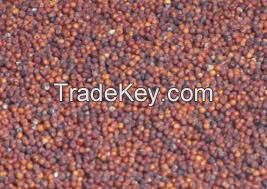Description
Millets, has protein content that is comparable to that of wheat
and maize. Pearl and little millet are higher in fat, while finger
millet contains the lowest fat. Barnyard millet has the lowest
carbohydrate content and energy value. Millets are also relatively
rich in iron and phosphorus. The bran layers of millets are good
sources of B-complex vitamins. Millets also feature high fiber
content and nutrients. Finger millet has the highest calcium
content among all the food grains.
The protein content in millet is very close to that of wheat; both
provide about *1% protein by weight, on a dry matter basis.
Millets are rich in B vitamins (especially niacin, B6 and folic
acid), calcium, iron, potassium, magnesium, and zinc. Millets
contain no gluten, so they are not suitable for raised bread. When
combined with wheat (or xanthan gum for those who have celiac
disease) they can be used for raised bread. Alone, they are suited
for flatbread.
As none of the millets are closely related to wheat, they are
appropriate foods for those with celiac disease or other forms of
allergies/intolerance of wheat.
